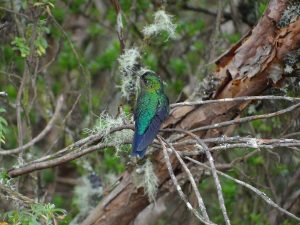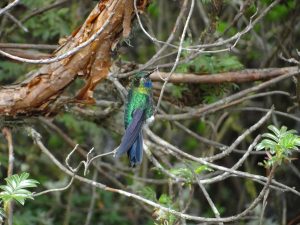By Susana Madera

Quito, Dec 15 (efe-epa).- Hidden among the clouds that caress a mountain in Quito, the Yanachocha nature preserve forest protects the blackbreasted puffleg, a rare type of tiny hummingbird.
About seven centimeters (2.75 inches) long and weighing just 10 grams (0.36 ounce), with black feathers on its breast but blue and violet ones on the rest of its body, depending on how the sunlight strikes them, the hummingbird has been declared the emblematic bird of Ecuador’s national capital, but it is a threatened species.
The Yanacocha preserve is located about 45 km (28 mi.) from Quito, is managed by the Jocotoco Foundation and is a zone ranging from 3,000-4,500 meters (9,840-14,760 feet) above sea level created to protect assorted birds and other endangered species.
The region includes high mountain forest, polylepis (a high-elevation tropical plant) and areas of scrubland.
There, the vegetation seems to play hide and seek with the clouds which, depending on the wind, cover and uncover in just minutes the mountainous terrain in which pumas, wolves, deer and spectacled bears, along with other species, roam.
The blackbreasted puffleg is also there, an endemic species in the area, but it is “critically threatened,” Efrain Cepeda, the director of the areas in the northern part of the Jocotoco Foundation’s lands, told EFE.
The Yanacocha preserve was created in 2001 on the northwestern slopes of the Pichincha volcano with the aim of preserving the blackbreasted puffleg (Eriocnemis nigrivestis).

The little bird can also be found in the Toisan mountains, the Intag Valley, and in the provinces of Esmeraldas and Imbabure, in northwestern Ecuador.
“All these sites were forest in the past and now the agricultural frontier has been growing and all that forest has been lost, and … above 3,500 meters, the process of natural regeneration is very slow,” he said.
Experts estimate that there are about 300 of the little birds in the area, but with so few specimens in the wild Cepeda asked: “How can we guarantee that this species is going to continue developing genetically?”
Living in the community of Yanacocha are about 20 families, who make their living basically from livestock raising and milk production, and one of the biggest challenges facing the Jocotoco Foundation in protecting endangered species is finding “ways to work, to coexist with the people” who are living in “difficult (economic) conditions,” Cepeda said.
Nevertheless, the foundation has managed to involve members of the community in economic activities related to ecological tourism and birdwatching.
In Yanacocha there is also a program under way – known as “Oxygen for the future,” one of Ecuador’s contributions to the fight against climate change – to restore habitats, including reforesting certain areas of pasture as well as areas that were burned in past wildfires.






